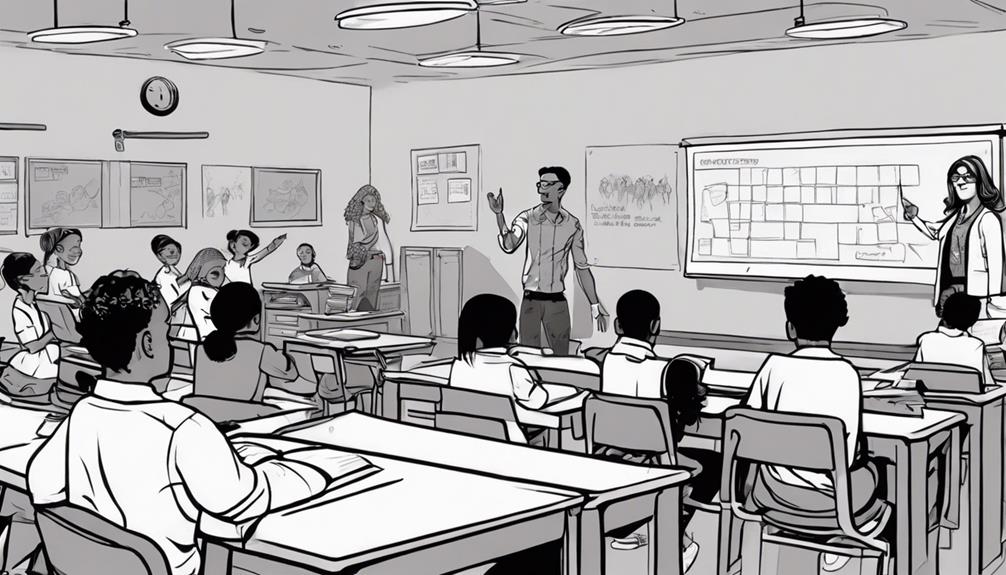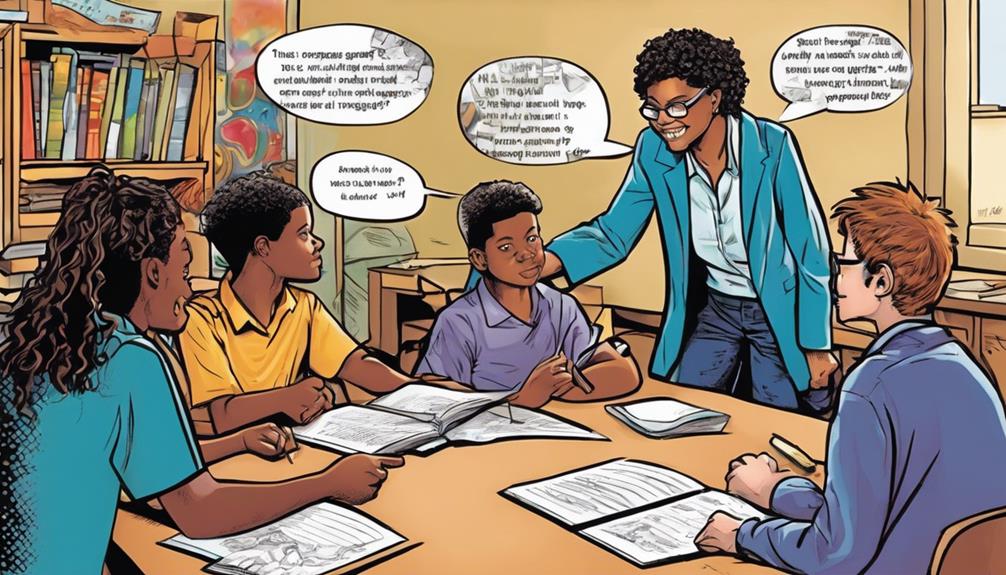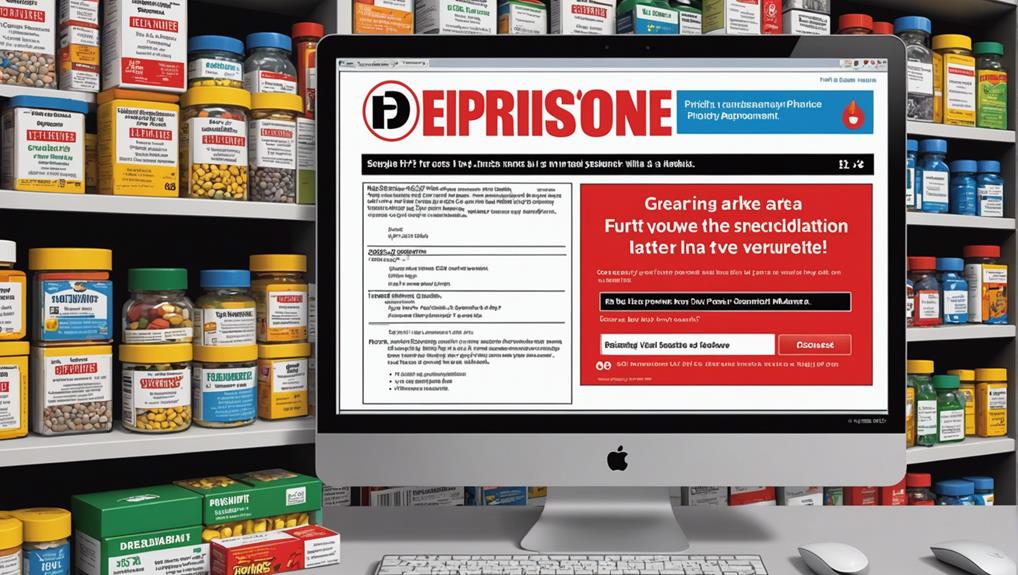Mastering classroom behavior involves meticulous lesson planning using engaging activities and the right resources. Creating a positive environment is key, showing interest in students and fostering a sense of community. Effective questioning keeps students engaged, while strategic proximity actions help maintain focus. Consistent sanctions and follow-up guarantee a fair and structured approach. By utilizing humor and active listening, we strengthen bonds and enhance learning. Want to uncover essential strategies for mastering classroom behavior? You're in for a treat with these insightful tips!
Key Takeaways
- Consistent application of school policies is crucial for managing behavior effectively.
- Establish a welcoming atmosphere to foster a positive classroom environment.
- Utilize strategic questioning to enhance student engagement and participation.
- Proximity actions, like standing close to off-task students, can help maintain focus.
- Follow-up on sanctions to ensure fairness, monitor behavior, and enforce detention attendance.
Lesson Planning and Engagement

Mastering classroom behavior begins with meticulously planning engaging lessons that captivate students' attention and foster a conducive learning environment. As a teacher, I find that by carefully structuring my lessons with a variety of activities, considering seating arrangements, and preparing necessary resources in advance, I can create an environment where students are enthusiastic to participate.
Using tools like the Teachers Lesson Plan and Record Book streamlines this process, allowing me to focus on delivering high-quality content. When students are actively engaged in well-thought-out activities, not only does behavior management become more manageable, but deep learning also takes place.
Investing time in lesson planning truly pays off during the school week, preventing disruptions and ensuring a productive learning atmosphere.
Building Positive Classroom Environment

To foster a positive classroom environment, I prioritize showing genuine interest in my students' lives and interests. By taking the time to get to know them on a personal level, I create a welcoming atmosphere where they feel valued and understood. This approach not only strengthens our teacher-student bond but also encourages a sense of community within the classroom.
Additionally, using humor to make classes enjoyable can lighten the mood and make learning more engaging. Regularly praising and encouraging students boosts their confidence and motivation. Involvement in extra-curricular activities further solidifies these connections, building rapport that forms the foundation of a positive classroom environment.
Effective Questioning Techniques

Utilizing strategic questioning in the classroom actively redirects student focus and enhances engagement during lessons. When I pose thought-provoking questions, it not only brings students back on task but also encourages active listening and participation.
Directing questions at specific students serves as a gentle nudge to regain attention, acting as a subtle warning to others to tune in. It's like a secret weapon in my teaching arsenal, helping address any pockets of low-level disruption swiftly and effectively.
Proximity Actions for Focus

When maintaining student focus in the classroom, standing close to off-task students can be a highly effective strategy. It allows me to quickly redirect their attention back to the task at hand.
Walking around the classroom during activities also helps in monitoring student engagement and ensuring everyone is on track. Especially during tasks that involve technology, like ICT-based projects, being vigilant and using proximity actions can greatly boost student focus and productivity.
Sanctioning and Follow-up Strategies

Maintaining a structured approach to enforcing school sanctions and implementing follow-up strategies is essential for managing classroom behavior effectively. Consistency in applying sanctions and follow-up measures guarantees a fair and purposeful disciplinary system. Here's a breakdown of key strategies:
| Sanctioning Strategies | Follow-up Strategies |
|---|---|
| Apply school policies consistently | Monitor ongoing behavior |
| Ensure fairness in sanctions | Guarantee detention attendance |
| Clarify the purpose of sanctions | Have individual discussions with students |
Frequently Asked Questions
How Can I Address Disruptive Behavior During Group Work Activities?
To address disruptive behavior during group work activities, I focus on proximity actions like standing near off-task students and monitoring progress. This helps maintain student focus and productivity, ensuring a conducive learning environment for all.
What Are Some Effective Ways to Handle Students Who Constantly Seek Attention?
When students constantly seek attention, I address it by redirecting focus with engaging tasks, praising positive behavior, and having private discussions to understand their needs. Consistent boundaries and positive reinforcement help manage attention-seeking behaviors effectively.
How Do I Encourage Shy Students to Participate in Class Discussions?
To encourage shy students to participate in class discussions, I create a supportive environment where everyone's ideas are valued. By offering praise for small contributions, allowing time for reflection, and fostering a safe space, participation increases.
What Should I Do if a Student Consistently Refuses to Follow Classroom Rules?
When a student consistently refuses to follow rules, I address the behavior privately, express expectations clearly, and offer support. Consistent consequences are essential. I involve parents and colleagues for a united approach, ensuring consistency and understanding.
How Can I Support Students Who Exhibit Behavioral Issues Due to Personal Struggles?
I support students facing personal struggles by offering a safe space to talk, showing empathy, and providing resources like counseling services. Building trust and understanding their challenges helps create a supportive environment for learning.
Conclusion
To sum up, mastering classroom behavior is like planting a seed – with the right care and attention, it will flourish and grow into a thriving educational environment.
By implementing key strategies such as effective lesson planning, positive classroom management techniques, and proactive behavior interventions, teachers can create a harmonious and productive space for learning.
Remember, as the saying goes, 'It takes a village to raise a child,' and together, we can cultivate a supportive and engaging classroom for all students.










